Malaria
Dengue Fever
West Nile Virus
Japanese Encephalitis
Arboviral Encephalitis: La Crosse, St. Louis, Western Equine, and Eastern Equine Encephalitis
Malaria
Vector:
Malaria’s
vector is the Anopheles mosquito.
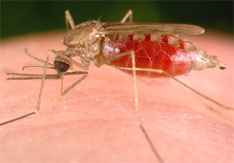 Vector of Malaria, Anopheles
Vector of Malaria, Anopheles
Center of Disease Control & Prevention
Distribution:
The disease is found mainly in Africa, Asia, and Latin America. 40% of the world's population is at risk of this disease.
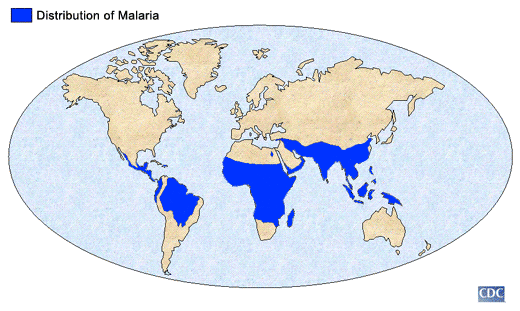
Centers for Disease Control & Prevention
Number of Cases:
There are over 500,000
cases globally per year with over 1 million deaths per year.
Transmission Cycle:
The mosquito
spreads the virus from person to person by the vector.
Symptoms:
The parasite first attacks the
liver and then the red blood cells. Some symptoms are headaches,
nausea, fever, and vomiting. There can be kidney and brain
complications that could result in a coma.
Vector:
The vector for this disease is Aedes Aegypti .
Distribution:
It is found in Asia, Australia, Africa, South, Central,
and North America.
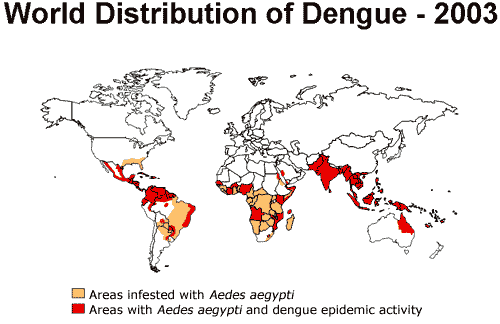
Centers for Disease Control & Prevention
This distribution shows the wide distance the disease has overcome.
Number of cases:
There are about 50 to 100 million cases per year
globally per year.
Transmission cycle:
The virus is past from human to human by this
mosquito.
Symptoms:
Some symptoms are rash, fever, headache, joint pain, pain
behind the eyes, muscle pain, nausea, and vomiting. In some cases the
illness might progress to dengue hemorrhagic fever which causes
internal bleeding and may be fatal.
West Nile Virus (
The disease is a type of encephalitis called arboviral encephalitis)
Vector:
This virus is spread by the culex species.
Distribution:
It is found in Africa, Europe, Middle East, Central Asia,
Oceania, and North America.
Transmission Cycle:
The virus cycles from mosquito to bird.
Humans and horses are incidental hosts.
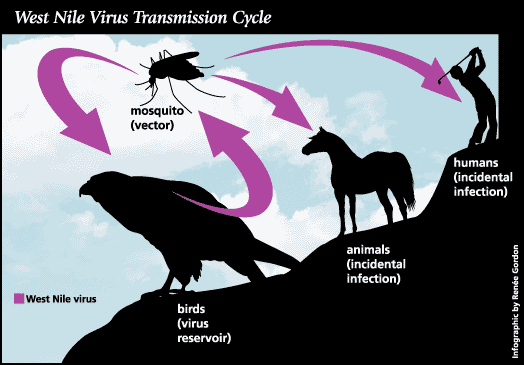
www.fda.org
The
virus uses the mosquito (the vector) to infect birds which are the main
reservoirs. The horses and humans are incidentals and the vector can
not get the virus back from feeding.
Number of cases:
In 2005 there were 3000 cases
and 119 deaths in US. There is a 3 to 15% mortality rate.
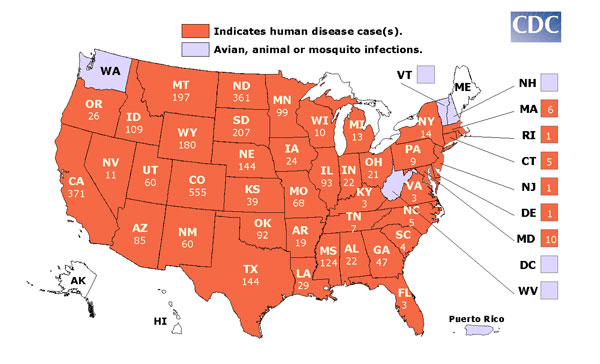
Centers for Disease Control & Prevention
This map shows the number of cases of West Nile in the year 2007.
Symptoms:
Some
symptoms are vomiting, fever, headaches, swollen lymph glands, body aches
and rash. It can sometimes lead to sever problems with the brain,
spinal cord, and nerves.
Japanese Encephalitis (this is an arboviral virus)
Vector:
This virus is spread by the Culex Tritaeniorhynchus mosquito.
Distribution:
It is found mostly in Asia and Australia.
Distribution Map of Japanese Encephalitis in Asia from 1970-98
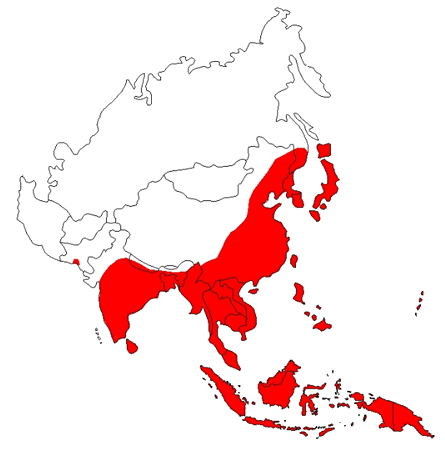
Centers for Disease Control & Prevention
This map shows how widespread the virus is in Asia. There even has been some cases in Australia.
Number of cases:
There are 35 to
50,000 cases per year with a mortality rate of 5 to 35% depending on availability of care.
Transmission cycle:
The virus is cycled from pig host or bird
host and back. Humans and horses are incidental hosts like in West Nile
virus and mosquitoes can not bite a person and get the virus back.
Symptoms:
In
most cases the symptoms is a fever or headache. In serious cases it can cause
paralysis, comas, seizures, and even death.
These viruses cause encephalitis and go
through a transmission cycle of a primary host of a bird or small
mammal.
Transmission Cycle:
The transmission cycle is about the same for the arboviral
viruses. There is a main cycle between mosquitoes and birds(or
sometimes small animals). The mosquitoes can bite people and horses by
accident giving them the virus. The mosquitoes can not get the virus
back from these hosts. They are called
dead-end hosts for this reason.
The following figure shows the common cycle for
La Crosse,
St. Louis,
Western Equine, and
Eastern Equine Encephalitis.
Center for Disease Control & Prevention
Symptoms:
Many people do not get symptoms or they
might get flu-like symptoms. Some people may get a sudden high fever
and headache. In few cases some people get encephalitis which causes
problems in the central nervous system including paralysis, comas, and
seizures. This can cause death.
La Crosse Encephalitis
This virus's vector is
Aedes triseriatus
and it goes through a
transmission cycle of chipmunks and squirrels to mosquitoes. Humans are
incidental hosts. It is found in the upper Mid-Western States,
Mid-Atlantic States, and Southeastern States. There is a mortality rate
of 1% a and there are 75
cases per year in the US.
St. Louis Encephalitis
St. Louis's vector are the
culex
species found in Central and Eastern US. There have been 4651 cases
from 1964 to 2005 in US. The virus has a mortality rate of 3 to 30%.
The cycle and the symptoms are described above.
Western Equine Encephalitis
This virus is found in North and South America. There have been 639 cases found in US since 1964. The
Culex tarsalis
is the mosquito vector. Horses are greatly affected by this virus with a
mortality rate of up to 50%. The cycle and symptoms are described above.
Eastern Equine Encephalitis
There have been 220 cases in US from
1964 to 2004. There are usually 5 cases per year. It is found in
Georgia, Florida, Massachusetts, and New Jersey. The Culiseta melanura is the vector for this virus. The cycle and symptoms are described above.
Definitions
Vector: An organism that carries a virus from a different organism to another.
Distribution: The known location of the virus.
Mortality rate: The average percent of deaths from the total infected by the virus.
Number of cases: The amount of people infected by the virus.
Transmission Cycle: The path a virus takes from the help of a vector. Also called a life cycle of the virus.
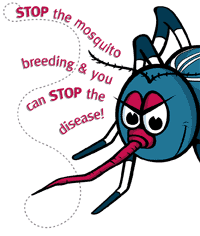
 Vector of Malaria,
Vector of Malaria,




